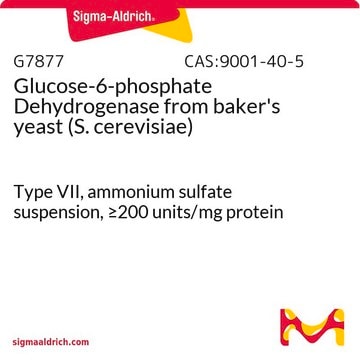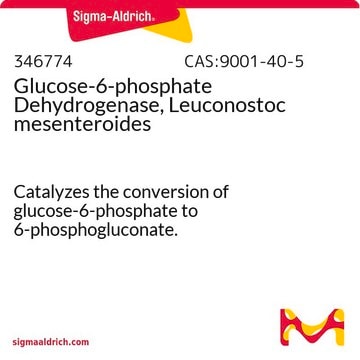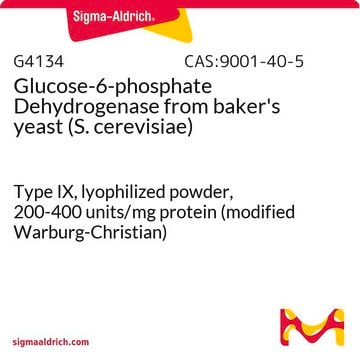P4553
6-Phosphogluconic Dehydrogenase from yeast
lyophilized powder, ≥3.0 units/mg solid
Synonym(s):
6-Phospho-D-gluconate:NADP+ 2-oxidoreductase (decarboxylating), 6-Phosphogluconic Dehydrogenase from yeast
Sign Into View Organizational & Contract Pricing
All Photos(1)
About This Item
CAS Number:
MDL number:
UNSPSC Code:
12352204
NACRES:
NA.54
Recommended Products
biological source
yeast
Quality Level
form
lyophilized powder
specific activity
≥3.0 units/mg solid
mol wt
52 kDa
storage temp.
2-8°C
Looking for similar products? Visit Product Comparison Guide
General description
6-Phosphogluconic Dehydrogenase from yeast comprises of a NADP+ binding domain, α helical hydrophobic interaction domain and a C-terminal domain. It exists as dimer and the C-terminal region is crucial for the substrate binding and release.
Application
6-Phosphogluconic Dehydrogenase from yeast has been used in hexokinase (HK) and xylose reductase (XR) activities in cell lysate.
Biochem/physiol Actions
Enzyme activity is determined by measuring the reduction of NAD+ or NADP+. High levels of NADPH are believed to inhibit the enzyme, while 6-phosphogluconate acts to activate the enzyme.
Unit Definition
One unit will oxidize 1.0 μmole of 6-phospho-D-gluconate to D-ribulose 5-phosphate and CO2 per min at pH 7.4 at 37 °C in the presence of NADP+.
inhibitor
Product No.
Description
Pricing
Signal Word
Danger
Hazard Statements
Precautionary Statements
Hazard Classifications
Resp. Sens. 1
Storage Class Code
11 - Combustible Solids
WGK
WGK 1
Flash Point(F)
Not applicable
Flash Point(C)
Not applicable
Personal Protective Equipment
dust mask type N95 (US), Eyeshields, Gloves
Choose from one of the most recent versions:
Certificates of Analysis (COA)
Lot/Batch Number
Don't see the Right Version?
If you require a particular version, you can look up a specific certificate by the Lot or Batch number.
Already Own This Product?
Find documentation for the products that you have recently purchased in the Document Library.
Customers Also Viewed
G Martínez-Drets et al.
Journal of bacteriology, 130(3), 1139-1143 (1977-06-01)
6-Phospho-D-gluconate:NAD+ 2-oxidoreductase (decarboxylating) (NAD+-6PGD) was detected in several slow-growing strains of rhizobia, and no activity involving NADP+ was found in the same extracts. By contrast, fast-growing strains of rhizobia had NADP+-6PGD activity; most of them also had NAD+-6PGD activity. NAD+-6PGD
Crystal structure of Saccharomyces cerevisiae 6-phosphogluconate dehydrogenase Gnd1
He W, et al.
BMC Structural Biology, 7(1), 38-38 (2007)
Ai-Hua Jin et al.
BMC structural biology, 7, 28-28 (2007-04-21)
Alpha-conotoxins have exciting therapeutic potential based on their high selectivity and affinity for nicotinic acetylcholine receptors. The spacing between the cysteine residues in alpha-conotoxins is variable, leading to the classification of sub-families. BuIA is the only alpha-conotoxin containing a 4/4
Enhancement of xylose uptake in 2-deoxyglucose tolerant mutant of Saccharomyces cerevisiae
Kahar P, et al.
Journal of Bioscience and Bioengineering, 111(5), 557-563 (2011)
Gluconate Kinase Is Required for Gluconate Assimilation and Sporulation in Cryptococcus neoformans.
Jezewski, et al.
Microbiology spectrum, 10, e0030122-e0030122 (2022)
Our team of scientists has experience in all areas of research including Life Science, Material Science, Chemical Synthesis, Chromatography, Analytical and many others.
Contact Technical Service










